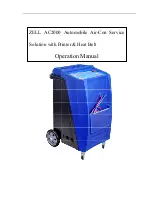
Kam Class 3R Laser Safety Guide
Important Warnings
Class 3R Lasers have the potential to harm eyesight only if viewed directly and persistently. Laser lighting effects are
quite safe to watch if installed and used correctly, and being aware of a few basic factors will help you to achieve this.
This guide has been prepared to help provide a basic backgrounder to the key safety aspects, and is based on
current UK health and safety guidance on the use of lasers for public displays.
Installation and Operation Notes
1. The laser should only be installed and operated by those that are aware of how to operate laser, and what the
various controls perform.
2. The laser should be mounted in a suitable and secure position in the venue, so that once in position it is unlikely to
be affected by unintended movement.
Introduction
Laser lighting products are used to create distinct and striking visual effects. The light that is used to create these
stunning effects is different from normal light and therefore several precautions need to taken when using lasers to
ensure that the lighting effects are safe and enjoyable to view. The optical power output from the kind of lasers used
for lighting displays can be harmful if not properly setup or is misused. But when used following the recommended
health and safety guidelines, laser lighting effects no more harmful than looking at any conventional lighting effect.
This guide has been put together to provide you with some background information about laser safety, and guidance
on the recommended health and safety requirements for using lasers in public places. Although this guide covers the
main points to consider when using laser effects, users are advised to familiarise themselves with other guidance,
particularly that issued by the Health and Safety Executive,
HS(G)95 The Radiation Safety Of Lasers Used For
Display Purposes
.
What is a laser?
A laser is device that produces a special kind of light that is different from normal light sources. Laser light sources
differ from normal light sources in that they produce very narrow and intense beams of light that can remain parallel
over long distances. It is this high concentration of light that can sometimes make lasers harmful to look directly into.
What is a Class 3R Laser?
Any device that contains a laser has to be classified depending upon the amount of laser light that someone might be
exposed to. During design and manufacture of the product, the manufacturer assigns the laser product to one of the
various classes defined in the
Safety of Laser Products Standard (BS/EN 60825-1:2014)
. The classes range from the
safest, which is
Class 1
, through to the most hazardous, which is
Class 4
.
For example, CD and DVD players contain lasers to read the disk, and because they are normally inaccessible to
people, they are classified as a
Class 1
laser products. Laser Pointers output more accessible power than CD/DVD
players and are normally limited to being
Class 2
devices. Most laser lighting effects units are
Class 3B
and
Class 4
laser products. These two classes have the highest potential to cause harm because they emit the most light output.
This is, of course, desirable and necessary for laser lighting effects! In between Classes 2 and 3B is Class 3R. This
class of laser is not intrinsically safe but the power emitted by these devices is not high enough to cause a major
injury in most cases. Persistent viewing of the emitted beam(s) should be avoided to minimise potential risk.
A laser device that emits between
1mW
and
5mW
of light can be classified as a
Class 3R
laser product.


























